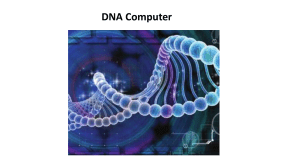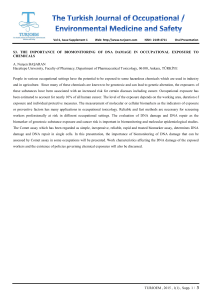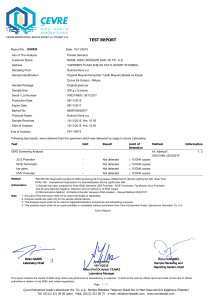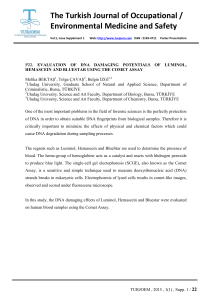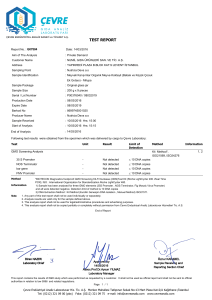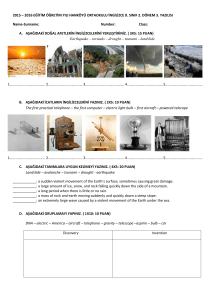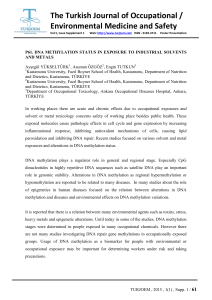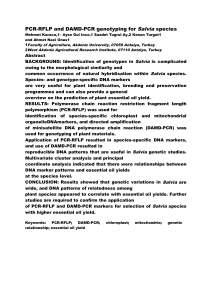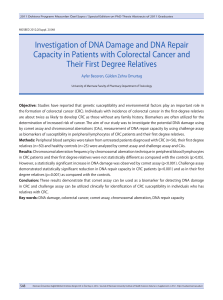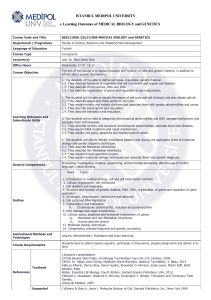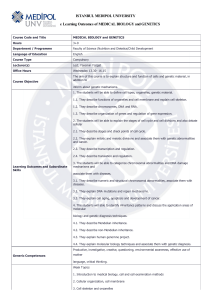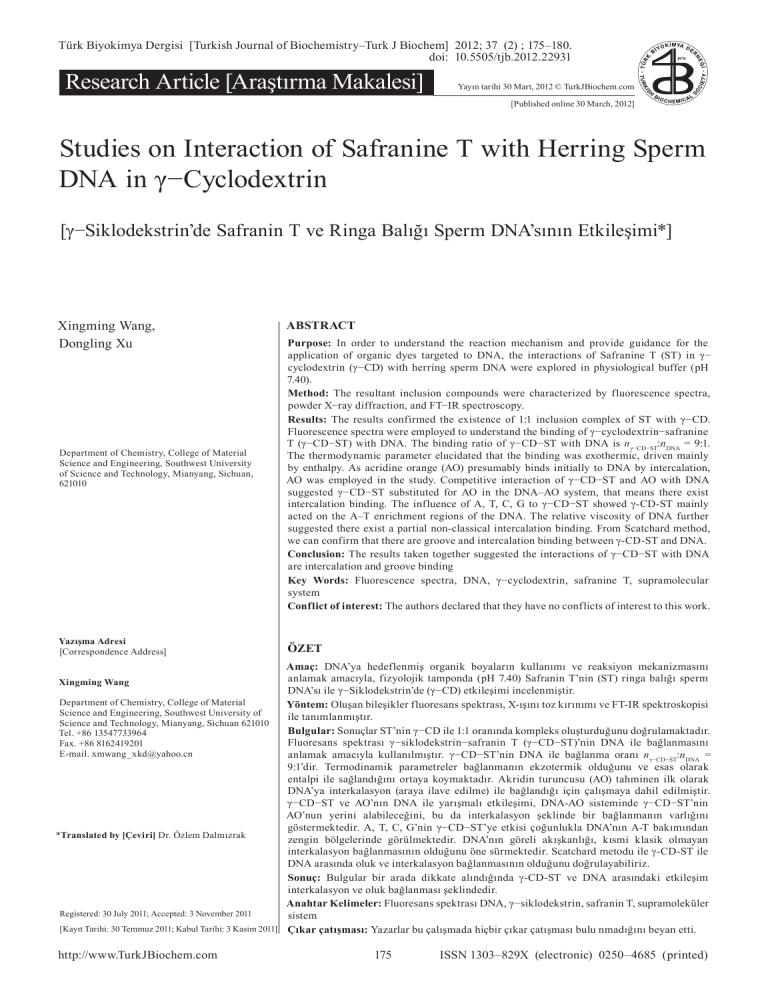
Türk Biyokimya Dergisi [Turkish Journal of Biochemistry–Turk J Biochem] 2012; 37 (2) ; 175–180.
doi: 10.5505/tjb.2012.22931
Research Article [Araştırma Makalesi]
Yayın tarihi 30 Mart, 2012 © TurkJBiochem.com
[Published online 30 March, 2012]
Studies on Interaction of Safranine T with Herring Sperm
DNA in γ−Cyclodextrin
[γ−Siklodekstrin’de Safranin T ve Ringa Balığı Sperm DNA’sının Etkileşimi*]
Xingming Wang,
Dongling Xu
Department of Chemistry, College of Material
Science and Engineering, Southwest University
of Science and Technology, Mianyang, Sichuan,
621010
Yazışma Adresi
[Correspondence Address]
ABSTRACT
Purpose: In order to understand the reaction mechanism and provide guidance for the
application of organic dyes targeted to DNA, the interactions of Safranine T (ST) in γ−
cyclodextrin (γ−CD) with herring sperm DNA were explored in physiological buffer (pH
7.40).
Method: The resultant inclusion compounds were characterized by fluorescence spectra,
powder X−ray diffraction, and FT−IR spectroscopy.
Results: The results confirmed the existence of 1:1 inclusion complex of ST with γ−CD.
Fluorescence spectra were employed to understand the binding of γ−cyclodextrin−safranine
T (γ−CD−ST) with DNA. The binding ratio of γ−CD−ST with DNA is nγ−CD−ST:nDNA = 9:1.
The thermodynamic parameter elucidated that the binding was exothermic, driven mainly
by enthalpy. As acridine orange (AO) presumably binds initially to DNA by intercalation,
AO was employed in the study. Competitive interaction of γ−CD−ST and AO with DNA
suggested γ−CD−ST substituted for AO in the DNA–AO system, that means there exist
intercalation binding. The influence of A, T, C, G to γ−CD−ST showed g-CD-ST mainly
acted on the A–T enrichment regions of the DNA. The relative viscosity of DNA further
suggested there exist a partial non-classical intercalation binding. From Scatchard method,
we can confirm that there are groove and intercalation binding between g-CD-ST and DNA.
Conclusion: The results taken together suggested the interactions of γ−CD−ST with DNA
are intercalation and groove binding
Key Words: Fluorescence spectra, DNA, γ−cyclodextrin, safranine T, supramolecular
system
Conflict of interest: The authors declared that they have no conflicts of interest to this work.
ÖZET
Amaç: DNA’ya hedeflenmiş organik boyaların kullanımı ve reaksiyon mekanizmasını
anlamak amacıyla, fizyolojik tamponda (pH 7.40) Safranin T’nin (ST) ringa balığı sperm
DNA’sı ile γ−Siklodekstrin’de (γ−CD) etkileşimi incelenmiştir.
Department of Chemistry, College of Material
Yöntem: Oluşan bileşikler fluoresans spektrası, X-ışını toz kırınımı ve FT-IR spektroskopisi
Science and Engineering, Southwest University of
ile tanımlanmıştır.
Science and Technology, Mianyang, Sichuan 621010
Bulgular: Sonuçlar ST’nin γ−CD ile 1:1 oranında kompleks oluşturduğunu doğrulamaktadır.
Tel. +86 13547733964
Fluoresans spektrası γ−siklodekstrin−safranin T (γ−CD−ST)’nin DNA ile bağlanmasını
Fax. +86 8162419201
E-mail. [email protected]
anlamak amacıyla kullanılmıştır. γ−CD−ST’nin DNA ile bağlanma oranı nγ−CD−ST:nDNA =
9:1’dir. Termodinamik parametreler bağlanmanın ekzotermik olduğunu ve esas olarak
entalpi ile sağlandığını ortaya koymaktadır. Akridin turuncusu (AO) tahminen ilk olarak
DNA’ya interkalasyon (araya ilave edilme) ile bağlandığı için çalışmaya dahil edilmiştir.
γ−CD−ST ve AO’nın DNA ile yarışmalı etkileşimi, DNA-AO sisteminde γ−CD−ST’nin
AO’nun yerini alabileceğini, bu da interkalasyon şeklinde bir bağlanmanın varlığını
göstermektedir. A, T, C, G’nin γ−CD−ST’ye etkisi çoğunlukla DNA’nın A-T bakımından
*Translated by [Çeviri] Dr. Özlem Dalmızrak
zengin bölgelerinde görülmektedir. DNA’nın göreli akışkanlığı, kısmi klasik olmayan
interkalasyon bağlanmasının olduğunu öne sürmektedir. Scatchard metodu ile g-CD-ST ile
DNA arasında oluk ve interkalasyon bağlanmasının olduğunu doğrulayabiliriz.
Sonuç: Bulgular bir arada dikkate alındığında g-CD-ST ve DNA arasındaki etkileşim
interkalasyon ve oluk bağlanması şeklindedir.
Anahtar Kelimeler: Fluoresans spektrası DNA, γ−siklodekstrin, safranin T, supramoleküler
Registered: 30 July 2011; Accepted: 3 November 2011
sistem
[Kayıt Tarihi: 30 Temmuz 2011; Kabul Tarihi: 3 Kasim 2011] Çıkar çatışması: Yazarlar bu çalışmada hiçbir çıkar çatışması bulu nmadığını beyan etti.
Xingming Wang
http://www.TurkJBiochem.com
175
ISSN 1303–829X (electronic) 0250–4685 (printed)
Introduction
Experiments and methods
Current studies of supramolecular interactions of organic dyes with biological molecules are significant to understand the structures and functions of bio−macromolecules [1], and can be used to imitate some biophysical
process. In general, a variety of organic dyes reversibly
have three distinct binding modes of non−covalent interaction with DNA [2]: intercalation into the base pairs,
in the major or minor grooves and outside the helix by
electrostatic interactions. These binding studies were
driven partly by the need to understand the mechanism
of organic dyes.
Materials
Organic dyes are stabilized on groove by binding and
intercalation with DNA through a series of associative
interactions such as hydrogen bond, attractive van der
Waals, hydrophobic interaction and so on [3]. The intercalative binding is stronger than other two binding
modes because the surface of intercalative molecule is
inserted into base pairs of DNA.
All of the samples were dissolved in Tris−HCl buffer
(pH 7.40, examined by acidometer). Tris and Safranine
T were purchased from Tianjin Kemi’ou chemical reagents center (A.R.). Acridine orange (AO) was purchased from Shanghai China Medicine Chemical Plant
(A.R.). γ−Cyclodextrin (γ−CD) were purchased from
Sichuan Chengdu China Kelong chemical plant (A.R.).
Other reagents were at least analytical grade, and were
used without further purification.
Cyclodextrins (CDs) are cyclic oligosaccharides containing six (α), seven (β), eight (γ) d−glucose units, and
guest molecules can be included in their relatively hydrophobic cavities [4–6]. As we know, the hydrophobic
effect can impel the hydrophobic groups of the guest
inside the cavity of CD and the hydrophilic groups are
located outside [7]. Safranine T (ST) is an available
biological dye, which features a planar phenazine ring
and a positive charge. Therefore, the planar hydrophobic phenazinyl moiety of ST is expected to facilitate intercalation of ST into the nonpolar interior of the DNA
helix [8]. So it can be used as a fluorescence probe
to investigate the structure of DNA molecules and to
construct a sensitive assay of DNA [9]. Its structure is
shown in Figure 1.
Figure 1. Molecular structure of Safranine T
In this study, the supramolecular interacting systems
were used to change the microenvironment of ST molecule that interacts with DNA. The strong absorption
and fluorescence characteristics of ST in γ−cyclodextrin provide sensitive spectroscopic changes to study its
interaction with DNA. The changes in the intensities of
these spectra can be used to explain the strength of the
stacking interaction between ST and the DNA base pairs
in γ−cyclodextrin.
Turk J Biochem, 2012; 37 (2) ; 175–180.
Herring sperm DNA was purchased from Sigma Biological Co. (USA) and used as received. Purity of DNA
was checked by monitoring the ratio of absorbance at
260−280 nm. The ratio was 1.89, indicating the DNA
was free from protein. The DNA was dissolved in doubly distilled deionized water with 50 mM NaCl and dialyzed for 48 h against a buffer solution at 277K. The
concentration of DNA stock solution was determined
according to the absorbance at 260 nm by using the extinction coefficient of 6600 (mol·cm) -1.
Instruments
The fluorescence spectra were recorded on a PE LS55
spectrofluorophotometer, made by Perkin Elmer Instrument Co., USA. The X−ray diffraction patterns were
collected on an X’Pert PRO diffractometer, made by
PAN−alytical B.V. The infrared spectra were recorded on
a Spectrum One spectrometry, made by PE Instrument
Co., USA. The pH was recorded on a pHS−2C acidometer (made in China). All of the spectroscopic work was
carried out at pH 7.40 maintained by a Tris–HCl buffer.
Procedures
Samples for fluorescence were prepared by mixing
known amounts of stock solutions of ST, DNA and
γ−CD in Tris–HCl buffer (pH 7.40) and diluted to the
required concentrations. The fluorescence titrations
were conducted by keeping the concentration of ST
constant while varying the concentration of γ−CD, or
keeping the concentration of γ−CD–ST inclusion complex constant while varying the concentration of DNA.
In fluorescence mode, both excitation and emission
bandwidths were set at 5 nm, λ ex = 411 nm 1.0 cm path
length quartz cuvettes were used for fluorescence measurements.
The powder X−ray diffraction operated at a voltage of 35
kV and a current of 50 mA. The samples were analyzed
in the 2θ angle range of (5–90) o and the process parameters were set as: scan step size of 0.02o, scan step time
of 1.54 s.
The infrared spectra of the samples were mixed with
KBr and compressed as disks. The selected wavenumber
ranged between 400 and 4000 cm−1 being the spectra
resolution of 4 cm−1 and 10 being the number of scans.
176
Wang and Xu.
Viscosity measurements were performed using a viscometer, which was immersed in a thermostat waterbath at 25 ±0.1 oC. An appropriate amount of γ−CD–ST
was added into the viscometer to give a certain r (r
= [γ−CD–ST] / [DNA]) value while keeping the DNA
concentration constant. After a thermal equilibrium
was achieved, the flow times of the samples were repeatedly measured with an accuracy of ±0.2 s by using
a digital stopwatch. The data were presented as (h/h0)
1/3
versus r, where h and h0 are the viscosity of DNA
in the presence and absence of γ−CD–ST, respectively.
Results and Discussion
Confirmation of γ−CD−ST inclusion complexes
Usually, when organic dyes interact with DNA and form
new complexes, changes in fluorescence should occur
[10]. The changes of the fluorescence spectra of ST are
inset in Figure 2. The fluorescence spectra of ST upon
increasing the concentration of γ−CD showed the reduction in the fluorescence intensities. When the concentration of γ−CD reached to 2.00x10 −5 mol.L−1, the fluorescence intensity became slow and was gradually leveled
off. It indicated that the ST was included completed by
γ−CD. In this process, the absorption maximum exhibited red shifted by 2 nm.
In order to determine the stoichiometry of the formation of γ−CD−ST inclusion complex, the mole ratio [11]
experiment was done at the peak 579 nm. The fluorescence spectra of ST upon increasing the concentration
of γ−CD were recorded, and then the graph was plotted
by mole ratio method. The mole ratio plots of ST with γ−
CD are shown in Figure 2. The inclusion complex has a
1:1 stoichiometry. The inclusion formation constant (K)
was a measure for complexing capacity of CDs, which
can be determined by the double−reciprocal method using the following equation [12]:
1/ (F0 −F) = [1/ (α·Kf )] · (1/cg−CD) + 1/α
where F0 and F are the fluorescence signals of ST in
the absence and presence of γ−CD, respectively. Kf is
the binding constant between γ−CD and ST. cγ−CD is the
concentration of γ−CD. α is a constant. And the binding
constants were calculated from the ratio of the intercept
on the vertical: Kf = 7.41x103 L.mol−1.
X−ray diffraction studies allow the identification of true
inclusion complexes of cyclodextrins, mainly based on
the empirical evidence that the powder XRD patterns
of these complexes should be clearly distinct from those
obtained by the superimposition of the diffractograms
of the individual components [13]. Figure 3 shows the
patterns for the inclusion complex γ−CD−ST (a), ST (b),
γ−CD (c) and physical mixture γ−CD and ST (d). The
diffractogram for the inclusion complex γ−CD−ST is
clearly different from the sum of the individual patterns
of ST (b) and γ−CD (c). The pattern of the inclusion
complex has two main peaks at 2θ = 17.6° and 22.8°. The
sharp diffraction peaks appear in spectra of both γ−CD
(c) and physical mixture (d), whereas the peaks disappear in the spectrum of the inclusion complex (a). This
phenomenon verifies the inclusion formation between
γ−CD and ST.
FT−IR is a useful tool to prove the presence of both guest
and components in the inclusion complex [14]. Figure 4
shows the infrared spectra of wavenumber from 4000
to 400 cm−1 of γ−CD (a), ST (b), physical mixture γ−CD
and ST (c) and the inclusion complex of γ−CD−ST (d).
The IR absorption peak of the physical mixture (c) is
simple superposition of the peak of γ−CD (a) and that of
ST (b).The γ−CD (a) spectrum shows a band at 3420.0
cm−1 due to the symmetric and antisymmetric O−H
stretching mode, a band at 2920.0 cm−1 due to the C−H
stretching mode and other bands at low wave number.
Some bands of the host and guest are affected by the formation of the inclusion complex resulting in a change of
position and relative intensities. The band at 3420.0 cm−1
of the γ−CD is shifted to high frequency at 3450.0 cm−1
in the inclusion complex. The absorption bands at 1420
and 1350 cm−1 of ST almost disappeared in the γ−CD−
ST inclusion complex, indicating that ST was entrapped
into the host cavities. The result is the same as that of X−
ray diffraction mentioned above. This also testifies that
the ST has entered into the cavity of γ−CD and formed
inclusion complex.
Binding studies
Figure 2. Mole ratio plots of ST with γ-CD in a Tris-HCl buffer (pH
7.40; λ = 579 nm);
cST = 2.00x10 -5mol·L -1. Inset: Fluorescence spectra of ST in different
concentrations of γ-CD (pH 7.40; λ ex = 411 nm). From curve 0-14, cST =
2x10 -5 mol·L -1; cγ-CD = 0.00, 0.25, 0.50, 0.75, 1.00, 1.25, 1.50, 1.75, 2.00,
2.25, 2.50, 2.75, 3.00, 3.25, 3.50×10 -5 mol·L -1, respectively.
Turk J Biochem, 2012; 37 (2) ; 175–180.
The changes in the fluorescence of γ−CD−ST with increasing concentrations of DNA are inset in Figure 5.
The fluorescence intensity of γ−CD−ST in the presence
of increasing amounts of DNA showed a strong decrease
and tended to constant at the high concentration of DNA,
which indicated the interaction of γ−CD−ST with DNA.
In order to determine the stoichiometry of the formation
of DNA−γ−CD−ST complex, the mole ratio experiment
was also done at the peak 579 nm. The mole ratio plots of
DNA with γ−CD−ST were shown in Figure 5. The binding ratio of the complex was: nγ−CD−ST:nDNA = 9:1.
177
Wang and Xu.
in order to characterize the interaction forces between
γ−CD−ST and DNA. The thermodynamic parameters of
binding reaction are the main evidence for confirming
the binding force. According to Thermodynamic equation of KӨ, ΔrHmӨ, ΔrGmӨ, ΔrSmӨand T:
lnK2Ө/ K1Ө = −ΔrHmӨ (1/T2−1/T1) /R (2)
ΔrGmӨ = −RTlnKӨ (3)
ΔrGm,TӨ = ΔrHmӨ−TΔrSmӨ (4)
where K1Ө and K2Ө refer to standard binding constants
of γ−CD−ST and DNA at 298.15K and 310.15K, respectively. T1 is 298.15K, T2 is 310.15K, ΔrHmӨ is standard molar reaction enthalpy. ΔrGmӨ refers to the standard molar
reaction Gibbs free energy. ΔrSmӨ refers to the standard
molar reaction entropy. Then ΔrHmӨ = −1.85x105 J·mol−1is
deduced. The negative result showed it was an exothermic reaction. The ΔrGmӨ298.15K = −2.56x104 J·mol−1. The
negative result showed spontaneous interaction tide
between γ−CD−ST and DNA. The ΔrSmӨ = −534.63
J·mol−1·K−1. The results suggested that the process of interaction of γ−CD−ST and DNA were mainly driven by
enthalpy [15−16].
Figure 3. X-ray diffraction patterns corresponding to the following
products: (a) γ-CD-ST; (b) ST; (c) γ-CD; (d) physical mixture.
Figure 4. IR spectra of γ-CD-ST systems: (a) γ-CD; (b) ST; (c)
physical mixture; (d) γ-CD-ST.
Competitive interaction of γ−CD−ST inclusion complex and AO with DNA
Further support for the mode of binding between γ−CD−
ST inclusion complex and DNA is given through the
competitive experiment. Here AO has been employed
in the examination of the reaction, as AO presumably
binds initially to DNA by intercalation. Figure 6 shows
the emission spectra of the DNA–AO system in the
absence and presence of γ−CD−ST. When the concentration of γ−CD−ST inclusion complex was added, a
remarkable fluorescence decrease of DNA–AO system
was observed at the maximum of 529 nm and there is a
new isosbestic point at 572 nm. This phenomenon suggested that γ−CD−ST substituted for AO in the DNA–
AO system which led to a large decrease in the emission
intensity of the DNA–AO system.
Figure 5. Mole ratio plots of γ-CD-ST with DNA in a Tris-HCl buffer
(pH 7.40; λ = 579 nm); cγ-CD-ST = 2.1.00x10 -5mol·L -1. Inset: Fluorescence
spectra of γ-CD-ST in different concentrations of DNA (pH 7.40; λ ex
= 411 nm). From curve 1-15, cγ-CD-ST = 2.1x10 -5 mol·L -1; c DNA = 0.00,
0.33, 0.67, 1.00, 1.33, 1.67, 2.00, 2.33, 2.67, 3.00, 3.33, 3.67, 4.00, 4.33,
4.67x10 -6 mol·L -1, respectively.
The fluorescence relationship between γ−CD−ST and
DNA was expressed by double reciprocal equation:
1/ (F0 −F) = [1/ (α·Kf )] · (1/cDNA) + 1/α
(1)
where F0 and F are the fluorescence signals of γ−CD−ST
in the absence and presence of DNA, respectively. Kf is
the binding constant between DNA and γ−CD−ST. cDNA
is the concentration of DNA. α is a constant.
The double reciprocal plots of 1/ (F0−F) versus 1/cDNA
are linear (at 298.15K and 310.15K, respectively), and
the binding constants are calculated from the ratio of
the intercept on the vertical: KӨ298.15K = 2.84×104 L·mol−1,
KӨ310.15K = 1.24×104 L·mol−1. Considering the dependence
of binding constant on temperature, a thermodynamic
process was considered to be responsible for the formation of the complex. Therefore, the thermodynamic
parameters dependent on temperatures were analyzed
Turk J Biochem, 2012; 37 (2) ; 175–180.
The influence of A, T, C, G to the inclusion
complex system
In order to further confirm the action mode between
γ-CD-ST and DNA, we also conducted a study on the
influence of A, T, C, G to the inclusion complex system. If the fluorescence spectra of the inclusion complex
has an obvious change by adding of these base pairs,
then there are two possibilities: First, γ-CD-ST effects
the base pairs of DNA through the major groove and
minor groove of DNA molecule. Second, the inclusion
complex can through the domain p system occurred
p–p interaction and hydrophobic interaction with the
p system of base pairs, which means that there are intercalation binding mode. Figure 7 shows the influence
of these base pairs to the inclusion complex system, the
fluorescence spectra of complex decreases steadily with
increasing the amounts of base pairs. The rates of change of base pairs are as follow: C: 21.1%; G: 29.7%; A:
178
Wang and Xu.
Figure 6. Emission spectra of DNA–AO mixture in different
concentrations of γ-CD-ST (pH7.40; λ ex = 411 nm). From curve 1-10,
c DNA–AO = 1.00×10 -5 mol·L -1; cγ-CD-ST = 0.00, 0.67, 1.33, 2.00, 2.67, 3.33,
4.00, 4.67, 5.33, 6.00 ×10 -5 mol·L -1, respectively.
Figure 8. Influence on DNA viscosity with different concentrations
of γ-CD-ST. c DNA = 1.00x10 -5 mol·L -1.
Figure 7. Fluorescence spectra of γ-CD-ST in different concentrations
of A, T, C, G (pH 7.40). From curve 0-10, cγ-CD-ST = 2.00x10 -5 mol·L -1;
cA, cT, cC, cG = 0.00, 0.20, 0.40, 0.60, 0.80, 1.00, 1.20, 1.40, 1.60, 1.80,
2.00×10 -4 mol·L -1, respectively.
Figure 9. Scatchard plots of DNA-γ-CD-ST in different concentrations
of AO (A:without NaCl; B: with NaCl. pH 7.40). c DNA = 1.00x10 -5
mol·L -1; Rt = cγ-CD-ST /c DNA; Rt = 1:0.00, 2:0.60, 3:1.20, 4:1.80.
en the inclusion complex γ-CD-ST and DNA.
39.4%; T: 35.5%. And as can be seen from these figures,
in the vicinity of 579 nm, the binding force of the inclusion complex with A and T are greater than C and G,
so that γ-CD-ST mainly acts on the A–T enrichment regions of the DNA. Therefore, we deduced that the interaction mode between γ-CD-ST inclusion complex and
DNA might be groove binding and intercalation binding.
Scatchard method
Viscosity measurements
Viscosity experiment is an effective tool to determine
the binding mode of small molecules and DNA. A classical intercalation binding demands the space of adjacent
base pairs to be large enough to accommodate the bound
ligand and to elongate the double helix, resulting in an
increase of DNA viscosity [17]. A partial non-classical
intercalation of the complex would reduce the DNA viscosity. A series of solutions was made which contained a
fixed concentration of DNA and various concentrations
of γ-CD-ST. Then, the viscosity measurements were
conducted at room temperature. The changes in relative viscosity of DNA with increasing concentrations
of γ-CD-ST inclusion complex are shown in Figure 8. It
can be seen that the relative viscosity of DNA decreased steadily with increasing amounts of γ-CD-ST. Such
behavior further suggested that a partial non-classical
intercalation binding should be the interaction mode of
γ-CD-ST with DNA.
Turk J Biochem, 2012; 37 (2) ; 175–180.
The binding mode between small molecules and DNA
can be determined using the Scatchard’s procedure [18].
Scatchard equation expresses the binding of AO-DNA in
the presence of γ-CD-ST:
r/c = K (n—r) (5)
where r is the moles of AO bound per mole of DNA, c
is the molar concentration of free AO, n is binding site
multiplicity per class of binding sites and K is the association binding constant of AO with DNA. Generally, it
is regarded as an intercalation binding mode if the values of n are same in the presence and absence of the
inclusion complex, and it is regarded as a nonintercalation binding mode if the values of K are same. And it is
regarded as mix binding mode including nonintercalation and intercalation binding if both the values of n and K
are changed. Two groups of buffers in presence of NaCl
and absence of NaCl as a contrast were constructed in
Figure 9. From the Scatchard plot, we can get the value
of K and n. The results are shown in Table 1.
As shown in Table 1, it can be seen that both values of
n and K changed with the different concentrations of
γ-CD-ST. The variation of the parameter n and K suggests a mix interaction herein. Normally, the values of
n in the presence of NaCl are lower than those in the
absence of NaCl, indicating there is an electrostatic in-
179
Wang and Xu.
Table 1. Data of Scatchard Equation of the interaction between g-CD-ST and DNA
Curve
a
b
c
d
c g-CD-ST /c DNA
K/ (L·mol-1)
n
2.74×103—7.94×104x
7.94×104
0.035
0
2.40×10 —8.84×10 x
8.84×104
0.027
0
0.50
2.95×103—8.44×104x
8.44×104
0.035
0.60
0
3.22×103—7.91×104x
7.91×104
0.041
1.20
0.50
4.21×10 —8.00×10 x
8.00×104
0.053
1.80
0
3.40×103—7.77×104x
7.77×104
0.044
0.50
4.00×10 —7.54×10 x
7.54×10
4
0.053
0
3.60×103—8.11×104x
8.11×104
0.044
NaCl %
Scatchard
0.50
3
3
3
teraction between small molecules and DNA. While in
Table 1, the values of n in the presence of NaCl are basically higher than those in the absence of NaCl, and combined with the results of base pairs, we can confirm that
there are groove binding and intercalation binding between the inclusion complex γ-CD-ST and DNA.
Conclusions
The binding interactions of γ-CD-ST with DNA in physiological buffer were illustrated with fluorescence spectroscopic techniques. The binding constants of γ-CD-ST
with DNA were measured at different temperatures and
the thermodynamic parameters were calculated as well.
The intercalative binding and groove binding of γ-CDST with DNA were deduced by taking account of relevant fluorescence spectra and viscosity measurements.
We believe that the binding mode of γ-CD-ST with DNA
studied here will provide useful information on the
mechanism of small molecules binding to DNA.
Conflict of interest: The authors declared that they
have no conflicts of interest to this work.
References
[1] Osborne SE, Ellington AD. (1997) Nucleic acid and the challenge of combinatorial chemistry. Chem Rev. 97: 349–370.
[2] Zhang GW, Hu X, Zhao N, Li WB, He L. (2010) Studies on the
interaction of aminocarb with calf thymus DNA by spectroscopic methods. Pestic Biochem Physiol. 98: 206–212.
[3] Queiroz MRP, Castanheira EMS, Carvalho MSD, Abreu AS,
Ferreira PMT, Karadeniz H, Erdem A. (2008) New Tetracyclic
heteroaromatic compounds based on dehydroamino acids: Photophysical and electrochemical studies of interaction with DNA.
Tetrahedron. 64: 382–391.
[4] Galian RE, Veglia AV, de Rossi RH. (1998) Cyclodextrin in enhanced fluorimetric method for the determination of tryptamine.
Analyst. 123: 1587–1591.
[5] Zhang GM, Shuang SM, Dong ZM, Dong C, Pan JH. (2002)
Investigation on the inclusion behavior of neutral red
with β-cyclodextrin, hydroxypropul-β-cyclodextrin and
sukfibutylether-β-cyclodextrin. Anal. Chim. Acta. 474: 189–195.
[6] Ikeda A, Hatano T, Konishi T, Kikuchi J, Schinkai S. (2003)
Host–guest complexation effect of 2,36-tri-o-methyl-beta-cyTurk J Biochem, 2012; 37 (2) ; 175–180.
4
4
4
clodextrin on a C-60-porphyrin light-to- photocurrent conversion system. Tetrahedron. 59: 3537–3540.
[7] Zhang GM, Pang YH, Shuang SM, Dong C, Choi MMF, Liu DS.
(2005) Spectroscopic studies on the interaction of safranine T
with DNA in β-cyclodextrin and carboxymethyl-β-cyclodextrin.
J Photochem Photobiol A 169: 153–158.
[8] Cao Y, He XW. (1998) Studies of interaction between safranine
T and double helix DNA by spectral methods. Spectrochim Acta
Part A. 54: 883–892.
[9] Huang CZ, Li YF, Liu XD. (1998) Determination of nucleic acids at nanogram levels with safranine T by a resconance lightscattering technique. Anal Chim Acta. 375: 89–97.
[10] Zhang LZ, Tang GQ. (2004) The binding properties of photosensitizer methylene blue to herring sperm DNA: a spectroscopic
study. J Photochem Photobiol B. 74: 119-125.
[11] Xi PX, Xu ZH, Liu XH, Chen FJ, Zeng ZZ, Zhang XW et al.
(2009) Synthesis, characterization, antioxidantactivity and
DNA-binding studies of three rare earth (III) complexeswith1(4-Aminoantipyrine) -3-tosylurealigand. J Fluoresc. 19: 63–72.
[12] Fei D, Wang XM, Li HB, Hu YM, Yu TT, Zhao N, Ding
LS. (2009) Research on the interaction mode between inclusion
complex γ-cyclodextrin-congo red and herring-sperm DNA.
Journal of Wuhan University of Technology. 31: 58-62.
[13] Braga SS, Gago S, Seixas JD, Valente AA. (2006) b-cyclodextrin and permethylated b-cyclodextrin inclusion compounds
of a cyclopentadienyl molybdenum tricarbonyl complex and
their use as cyclooctene epoxidation catalyst precursors. Inorg
Chim Acta. 359: 4757–4764.
[14] Li JY, Yan DY, Jiang XL, Chen Q. (2002) Formation of the
crystalline inclusion complex between γ-cyclodextrin and poly
(N-acetylethylenimine). Polymer. 43: 2625-2629.
[15] Li HB, Tuo HG, Wang XM, Wang SQ, Ding LS. (2008)
Study on interaction between hematoporphyrin dihydrochloride and herring sperm DNA by spectroscopy. Acta Opt Sin. 10:
2015–2021.
[16] Ross PD, Subramanian S. (1981) Thermodynamics of protein association reactions: Forces contributing to stability. Biochemistry. 20: 3096–3102.
[17] Lerman LS. (1961) Structural considerations in the interaction of DNA and acridines. J Mol Biol., 3: 18–30.
[18] Mansuri-Torshizi H, Mital R, Srivastava1 TS, Parekh H, Chitnis MP. (1991) Synthesis, characterization, and cytotoxic studies of α-diimine/1,2-diamine platinum (II) and palladium (II)
complexes of selenite and tellurite and binding of some of these
complexes to DNA. J Inorg Biochem. 44: 239–247.
180
Wang and Xu.

